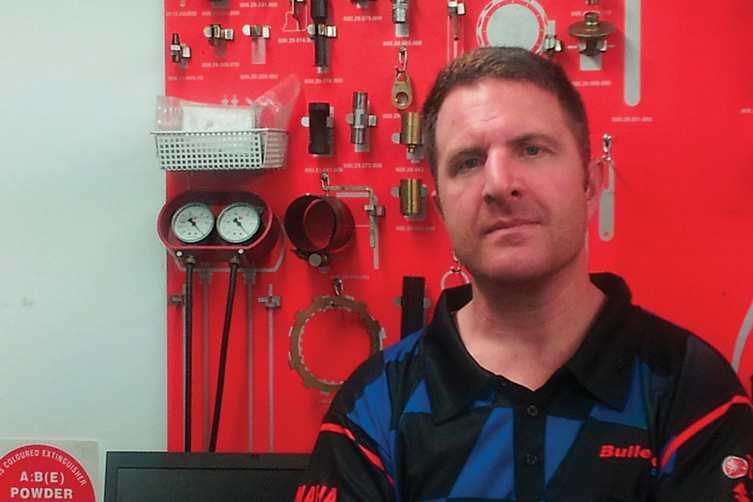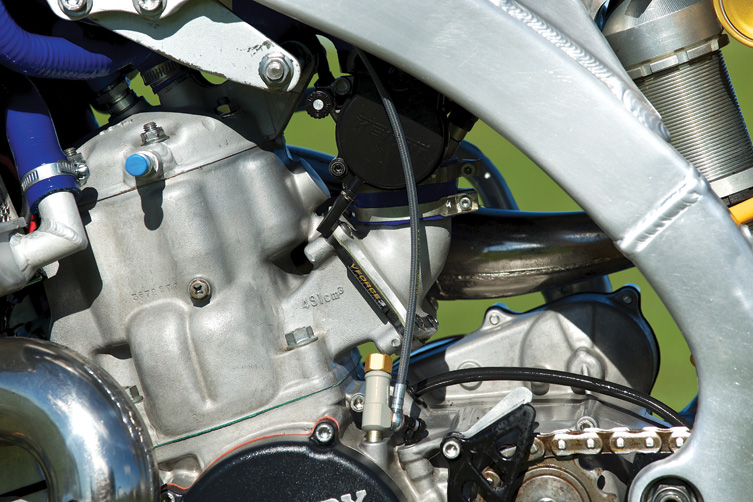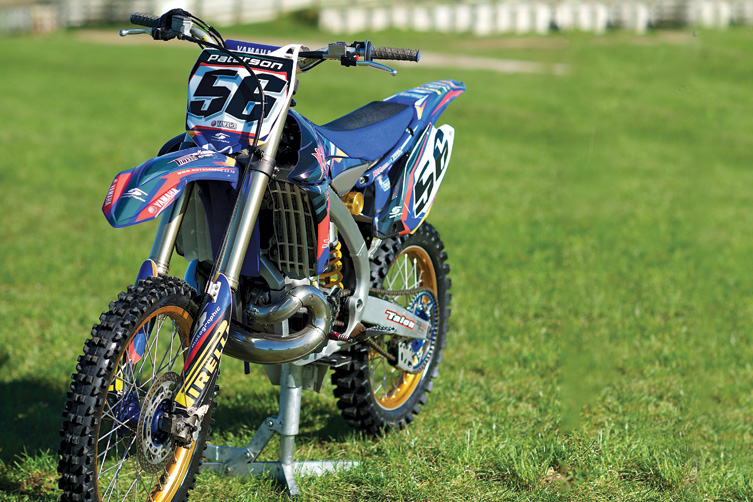
Words: Martin Child & Will Coole | Photos: Alick Saunders
Presented with a 2012 YZ450F suffering a blown engine, Mark Barrett reckoned a 500cc two-stroke donk was the only way forward – as long as it was fuel-injected. Hundreds of hours later, here is the unique result…
It’s a desert racer’s wet dream; a horsepower junkie’s ultimate score. And to the technologically savvy, a long awaited glance into the future of off-road motorcycles. Take a crate-fresh engine from one of the most intimidating off-road motorcycles ever produced – Honda’s legendary CR500 – and fit it with fully programmable EFI. Sounds straightforward enough. But then so does space travel. Graft that smoking heart between the frame rails of a modern, lightweight motocrosser and adorn the result with quality suspension. So what’s the destiny of this fusion of old and new tech? A controllable missile of a bike that, in the right hands, is pretty much unbeatable at your local track. Welcome to the tame beast that is the YZR500Fi.
It’s a creation of Mark “Big Red” Barrett using his extensive knowledge, hard earned from 18 years of working for some of the top superbike and motocross teams in the UK. The owner’s brief was to produce a machine that was both unique and ahead of its time. While brands such as Ossa and Bombardier may have already produced fuel-injected two-stroke engines, Mark’s YZR500Fi is self-engineered without the aid of factory budgets and just might be an accurate glance into what could become a player in the commercial dirt bike market over the next few years.
EFI
It took over 500 hours of Mark’s time to develop the system fitted to the YZR500Fi. Having to modify the intake system to fit into the reverse-cylinder chassis of the YZ-F proved a challenge, so a custom vertical intake manifold was manufactured to allow for the position of the airbox. A wiring harness was constructed from scratch before the EFI system could be installed. Mark took a Keihin throttle body and machined it to meet the YZR’s needs. The system is fully adjustable and can be changed to suit alternate fuels (can run on nitro, methanol and race fuels), and can even accommodate a turbo. And all these settings are just the touch of a computer button away…
ENGINE
Mark wanted an engine that could be easily replaced, so an US-sourced 2001 Honda CR500 donk was pulled straight out of the box. A decompression valve was fitted to allow mortal men to kick over this mechanical thunderbox, while a Crankworx crank takes up residence downstairs to smooth out the big single’s vibration. A Magura hydraulic clutch provides smoother modulation than the cable-operated original.
CHASSIS
The chassis was attacked from every angle to accommodate its new mechanical heart. The front section (known as the “Y”) and engine mounts are completely re-engineered and machined from billet aluminium before being welded and bolted back into place. The top section uses chromoly steel for added strength, while the sub-frame receives additional strengthening. The level of craftsmanship is evident by the factory-look of the welds.
SUSPENSION
Öhlins suspension was fitted front and rear, and re-valved and re-sprung to suit an 80kg rider. The steering offset and head angle were left standard and Mark says the Öhlins suspension complements the whole package, giving the machine a more compliant ride that matches the nature of the engine’s power delivery well. There’s no denying that the gold-coated Öhlins hardware also provide a certain amount of “bling”.
POWER-TRAIN
After much work on the best final drive ratio for the YZR, 13/49 gearing was found to be the best compromise to offer smooth power delivery whilst taking full advantage of the torque produced by the big two-banger. Energy is transferred using Talon sprockets and a DID chain; back to a set of Excels rims that are laced to Talon hubs with Buchanan spokes. Pirelli rubber gets the nod of attempting to pass the tested 68hp to the ground.
A GLANCE INTO THE FUTURE
Two-stroke injection technology isn’t new. F1 powerboats have been running 480hp direct-injected V6 two-stroke engines for the last few years and Bombardier has developed an 800cc direct-injected two-stroke engine for use in their popular snowmobile line-up since 2010. While battery technology looks to be evolving rapidly and could well see a competitive electro machine in the commercial market somewhere in the next five years, people like Mark Barrett are looking at under-developed two-stroke technology and “re-inventing the wheel”. The benefits are obvious – cheaper and more energy-efficient to produce than a four-stroke, a better power-to-weight ratio, less maintenance, less reciprocating mass, the list goes on. If injection technology is developed to a point where riders can get the four-stroke characteristics that they have become accustomed to from a two-stroke engine, then we could see a major rebirth in the banger. No more pinging into corners, no more annoying unstable idle and no more bogging. Imagine a two-stroke that hums at a set-idle RPM and produces usable torque from the bottom through to a screaming two-stroke top-end. Hopefully concepts like the Barrett’s YZR500Fi will become a part of the future of off-road motorcycles. Time will tell.

THE BUILDER – MARK BARRETT
The challenge was to bring the CR500 engine into the modern era and the addition of fuel injection is the only way to achieve this. As it needs its own electrical power supply, the bike can easily have a lighting set-up and I’m working on the possibility of fitting an electric starter. The bike weighs 105kg ready to ride (against the standard bike’s 111kg), even with the additional electrics (the 500 engine is much lighter then the 450). There’s a knack to starting the bike and, once learnt, she’ll fire with one swing. The next project will see a David Bailey replica (with the CR engine mated into a CRF-R chassis) and that will be an easier fit as the Yamaha’s chassis had to be modified in three major areas (front downtube, swingarm pivot and engine mounts). Lift the tank on the YZR and there’s not a shred of daylight to be seen. Nothing rubs but it’s a tight squeeze. Luckily the lack of servicing means that’s not a major issue. This bike has been a work in progress – both in terms of the technology needed for the FI system and to gauge interest in offering conversion kits in the future. The plan is to eventually sell complete bikes and kits through Bullet Bikes (Mackay, Qld: 0419 400325).”
 THE RIDER – PETER BROXHOLME
THE RIDER – PETER BROXHOLME
Peter Broxholme is a Kiwi Pro-level motocrosser and rider trainer. Here’s what he has to say after spending time on the YZR500Fi: “There is definitely a knack to starting it. This was more the fact that it’s a 500 than because of the fuel injection. I gave up kicking it more out of fear of ending up with a kick-start embedded in my calf than frustration after just two kicks. I was expecting a ruthless animal so made sure I was practically resting my chest on the bars while giving the herbs and leaning back like I had caught a whiff of something nasty under brakes, and eventually relaxed my death grip on the bars because it never even hinted like it was going to buck me off the back. There was no nasty power hike and it revved forever. It wasn’t long before I thought I could moto the bike quite happily. I think we could have a battle royale between two- and four-stroke bikes in every class if this concept became a commercial reality. As the air/fuel ratio and ignition maps can be altered via the EFI, the engine can be tuned to create huge torque and power or detuned for rideability – the possibilities are endless in finding the right combo for any rider. Scoring the current set-up out of 10, I would give the YZR500Fi a nine for both coolness and fun factor. For racing as it is now, I would say a four – mainly due to being too scared to stall it on the line and not be able to start it again. Overall, it gets a seven from me.”
This article originally appeared in Transmoto Dirt Bike Magazine‘s 2012 December Issue (#26).



